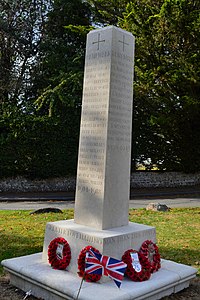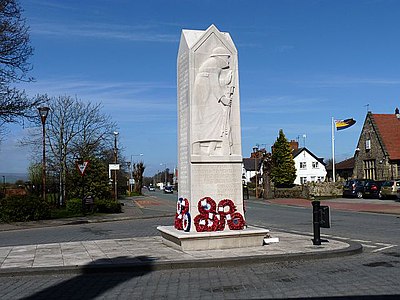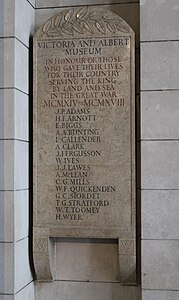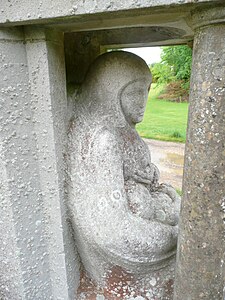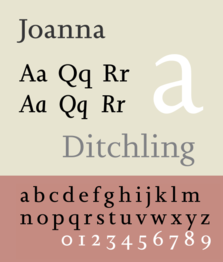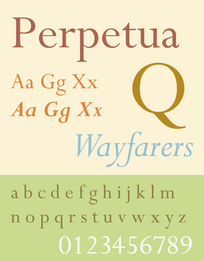Eric Gill
Eric Gill | |
|---|---|
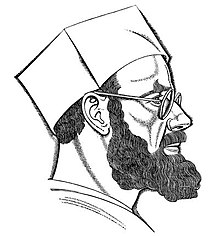 Self-portrait | |
| Born | Arthur Eric Rowton Gill 22 February 1882 Brighton,Sussex, England |
| Died | 17 November 1940(aged 58) Middlesex,England |
| Education |
|
| Known for | Sculpture,typography |
| Movement | Arts and Crafts movement |
| Spouse |
Ethel Hester Moore (m.1904) |
| Children | 4 |
Arthur Eric Rowton GillARARDI(22 February 1882 – 17 November 1940) was an English sculptor,letter cutter,typeface designer,andprintmaker.Although theOxford Dictionary of National Biographydescribes Gill as "the greatest artist-craftsman of the twentieth century: a letter-cutter and type designer of genius", he is also a figure of considerable controversy following the revelations of hissexual abuseof two of his daughters and of his pet dog.
Gill was born inBrightonand grew up inChichester,where he attended the local college before moving to London. There he became an apprentice with a firm of ecclesiastical architects and took evening classes in stone masonry and calligraphy. Gill abandoned his architectural training and set up a business cutting memorial inscriptions for buildings and headstones. He also began designing chapter headings and title pages for books.
As a young man, Gill was a member of theFabian Society,but later resigned. Initially identifying with theArts and Crafts Movement,by 1907 he was lecturing and campaigning against the movement's perceived failings. He became a Roman Catholic in 1913 and remained so for the rest of his life. Gill established a succession of craft communities, each with a chapel at its centre and with an emphasis on manual labour as opposed to more modern industrial methods. The first of these communities was atDitchlingin Sussex, where Gill established theGuild of St Joseph and St Dominicfor Catholic craftsmen. Many members of the Guild, including Gill, were also members of theThird Order of Saint Dominic,alaydivision of theDominican Order.At Ditchling, Gill and his assistants created several notable war memorials including those atChirkin north Wales and atTrumpingtonnear Cambridge, along with numerous works on religious subjects.
In 1924, the Gill family left Ditchling and moved to an isolated, disused monastery atCapel-y-ffinin the Black Mountains of Wales. The isolation of Capel-y-ffin suited Gill's wish to distance himself from what he regarded as an increasingly secular and industrialised society, and his time there proved to be among the most productive of his artistic career. At Capel, Gill made the sculpturesThe Sleeping Christ(1925),Deposition(1925), andMankind(1927). He created engravings for a series of books published by theGolden Cockerel Pressconsidered among the finest of their kind, and it was at Capel that he designed the typefacesPerpetua,Gill Sans,andSolus.After four years at Capel, Gill and his family moved into a quadrangle of properties atSpeenin Buckinghamshire. From there, in the last decade of his life, Gill became an architectural sculptor of some fame, creating large, high profile works for central London buildings, including both the headquarters of the BBC and the forerunner of London Underground. His mammoth friezeThe Creation of Manwas the British Government's gift to the newLeague of Nationsbuilding inGeneva.Despite failing health Gill was active as a sculptor until the last weeks of his life, leaving several works to be completed by his assistants after his death.
Gill was a prolific writer on religious and social matters, with some 300 printed works including books and pamphlets to his name. He frequently courted controversy with his opposition to industrialisation, modern commerce, and the use of machinery in both the home and the workplace. In the years preceding World War II, he embraced pacifism and left-wing causes.
Biography
[edit]Early life
[edit]Eric Gill was born in 1882 in Hamilton Road,Brighton,the second of the 13 children of the Reverend Arthur Tidman Gill and (Cicely) Rose King (died 1929), formerly a professional singer oflight operaunder the name Rose le Roi.[1]Arthur Tidman Gill had left theCongregational Churchin 1878 over doctrinal disagreements and became a minister of theCountess of Huntingdon's Connexion,a grouping of Calvinist Methodists.[2]: 7 Arthur was born in the South Seas, where his father, George Gill, was a Congregational minister and missionary.[2]: 5 Eric Gill was the elder brother of the graphic artistMacDonald "Max" Gill(1884–1947).[1]Two of his other brothers, Romney and Cecil, became Anglican missionaries while their sister, Madeline, became a nun and also undertook missionary work.[2]: 5 The film historianDavid Gillwas a nephew.
In 1897, the family moved toChichester,when Arthur Tidman Gill left the Countess of Huntingdon's Connexion, became a mature student atChichester Theological Collegeand joined theChurch of England.[1][2]: 19 Eric Gill studied at Chichester Technical and Art School, where he won a Queen's Prize for perspective drawing and developed a passion for lettering.[2]: 26 Later in his life, Gill cited the Norman and medieval carved stone panels inChichester Cathedralas a major influence on his sculpture.[3][4]In 1900, Gill became disillusioned with Chichester and moved to London to train as an architect with the practice ofW. D. Caröe,specialists in ecclesiastical architecture with a large office close toWestminster Abbey.[1]
London 1900–1907
[edit]Frustrated with his architectural training, Gill took evening classes instonemasonryat theWestminster Technical Instituteand, from 1901, incalligraphyat theCentral School of Arts and Craftswhile continuing to work at Caröe's.[5]The calligraphy course was run byEdward Johnston,creator of theLondon Underground typeface,who became a strong and lasting influence on Gill.[2]: 42 For a year, until 1903, Gill and Johnston shared lodgings atLincoln's Innin central London.[2]: 49
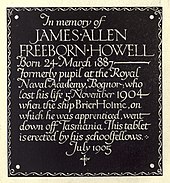
During 1903, Gill gave up training in architecture to become a calligrapher, letter-cutter and monumental mason.[6]After making a copy of a small stone tablet from Westminster Abbey, Gill's first public inscription was for a stone memorial tablet, to a Percy Joseph Hiscock, in Chichester Cathedral.[2]: 45 Through a contact at the Central School, Gill was employed to cut the inscription for a tombstone atBrookwood Cemeteryin Surrey.[2]: 45 Other work quickly followed, including an inscription forHoly Trinity, Sloane Street,plus commissions from architects and private individuals, includingCount Kessler.[2]: 93 Kessler, on Johnston's recommendation, employed Gill to design chapter headings and title pages for theInsel Verlagpublishling house.[5]W.H. Smith & Sonemployed Gill to paint the lettering on the fascias of several of their bookshops including, in 1903, their Paris store.[2]: 55 For a time, Gill combined this work with his job at Caröe's but eventually the scale and frequency of these commissions required him to leave the company.[2]: 88 After Gill died, his brother, Evan, compiled an inventory of 762 inscriptions known to have been carved by him.[2]: 45
In 1904, Gill married Ethel Hester Moore (1878–1961), a former art student, later known as Mary, the daughter of a businessman who was also the head verger at Chichester Cathedral.[2]: 31 Gill and Moore would eventually have three daughters and foster a son.[1]After a short period inBattersea,the couple moved into 20Black Lion Lane,Hammersmithin west London, near the, recently married, Johnstons' home on Hammersmith Terrace.[7]A number of artists associated with theArts and Crafts movement,includingEmery Walker,T. J. Cobden-SandersonandMay Morriswere already based in the area, as were a number of printing presses, notably theDoves Press.[2]: 64 Gill formed a business partnership with Lawrence Christie and recruited a number of staff, including the 14-year oldJoseph Cribb,to work in his studio.[2]: 66 Gill began giving lectures at the Central School and taught courses in monumental masonry and lettering for stonemasons at thePaddington Institute.[2]: 102 In 1905, he was elected to theArts and Crafts Exhibition Societyand joined theFabian Societythe following year.[2]: 101 After a period of intense involvement with the Fabians, Gill became disillusioned with both them and the Arts and Craft movement. By 1907 he was writing and making speeches about the failures, both theoretical and practical, of the craft movement to resist the advance of mass-production.[2]: 93
In his diaries, Gill records two affairs while living at Hammersmith. He had a brief affair with the family maid while his wife was pregnant and then a relationship with Lillian Meacham, who he met through the Fabian Society.[2]: 95 Gill and Meacham visited the Paris Opera andChartres Cathedraltogether and when their affair ended, she became an apprentice in Gill's workshop and remained a family friend throughout his life.[2]: 95
Ditchling Village 1907–1913
[edit]In 1907, Gill moved with his family to Sopers, a house in the village ofDitchlingin Sussex, which would later become the centre of an artists' community inspired by Gill. Although by April 1908 Gill had established a workshop in Ditchling and dissolved his business partnership with Lawrence Christie, he continued to spend considerable amounts of time in London visiting clients and delivering lectures, while his wife Ethel organised their household and smallholding in Sussex.[2]: 120 In London, Gill would stay at his old lodgings in Lincoln's Inn with his brother Max or with his sister Gladys and Ernest Laughton, her future husband.[2]: 122 Gill continued to concentrate on lettering and inscriptions for stonework and employed a pupil for his signwriting business.[2]: 126 He also began to use wood engraving techniques for his book illustration work, notably for a 1907 edition ofHomerfor Count Kessler.[2]: 126
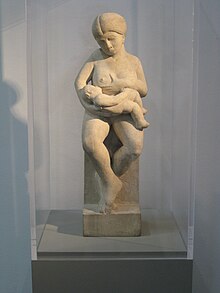
Late in 1909, Gill decided to become a sculptor.[2]: 126 Gill had always considered himself an artisan craftsman rather than an artist. He rejected the usual sculpture technique of first making a model and then scaling up using apointing machine,in favour of directly carving the final figure.[4][8]His first sculptures includedMadonna and Child(1910), which the art criticRoger Frydescribed as a depiction of "pathetic animalism",[9]and the almost life-size work now known asEcstasy(1911).[4]The models forEcstasywere his sister Gladys Gill and her husband Ernest Laughton.[2]: 104 [10]The incestuous relationships between Gill and Gladys that continued during their lives had already begun at this point.[2]: 104 [4]There is also some evidence, from Gill's own writings, of an incestuous relationship with Angela, another of his sisters.[2]: 105 [10]
An early admirer of Gill's sculptures wasWilliam Rothensteinand he introduced Gill, who was fascinated byIndian temple sculptures,to theCeylonesephilosopher and art historianAnanda Coomaraswamy.[11]Along with his friend and collaboratorJacob Epstein,Gill planned the construction in the Sussex countryside of a colossal, hand-carved monument in imitation of the large-scale structures atGwalior FortinMadhya Pradesh.[12]Throughout the second half of 1910, Epstein and Gill would meet on an almost daily basis, but eventually their friendship soured very badly. Earlier in the year they had held long discussions with Rothenstein and other artists, includingAugustus JohnandAmbrose McEvoy,about the formation of a religious brotherhood.[2]: 102 At Ditchling, Epstein worked on elements ofOscar Wilde's tombinPère Lachaise cemeteryfor which Gill designed the inscription before sending Joseph Cribb, who had moved to Ditchling in 1907, to Paris to carve the lettering.[2]: 135 [13]
Gill had his first sculpture exhibition in 1911 at the Chenil Gallery in London.[9]Eight works by Gill were included in the Second Post-Impressionism Exhibition organised by Roger Fry at theGrafton Galleriesin London during 1912 and 1913.[13]
By 1912, while Gill's main source of income was from gravestone inscriptions, he had also carved a number ofMadonnafigures and was widely assumed, wrongly at that time, to be aCatholicartist. As such he was invited to an exhibition of Catholic art in Brussels and, on route, stayed for some days at theBenedictinemonastery atMont-César AbbeynearLouvain.[2]: 94 Gill's experiences at Louvain, seeing the monks at prayer and hearingplainsongfor the first time convinced him to become a Catholic.[14]In February 1913, after religious instructions from English Benedictines, Gill and Ethel were received into the Catholic Church and Ethel changed her name to Mary.[2]: 147
Westminster Cathedral 1914–1918
[edit]
In 1913, after Gill and his wife became Roman Catholics they moved to Hopkin's Crank atDitchling Common,two miles north of Ditchling village.[1]There, Gill worked primarily for Catholic clients, notably his 1914 commission for the 14stations of the crossinWestminster Cathedral.[1][15]Gill was a surprising choice for the commission as he had only recently become a Catholic and had only been a sculptor for three years.[16]However he was prepared to do the work quicker and for a lower fee than more established sculptors would.[16]Gill modelled both the Christ figure in panel ten and a soldier in the second panel on himself.[15]The Stations were not universally well received when they were erected with criticism of their simple appearance and how starkly they contrasted with the rest of the cathedral interior.[16]A minority, that eventually includedNikolaus Pevsner,praised their uncluttered design and unsentimental treatment of the subject.[16]They are now considered among Gill's most accomplished large scale works.[2]: 125 Subsequently, Gill submitted proposals for decorations and works in other parts of the Cathedral building and, eventually, his design for the Chapel of Saint George and the English Martyrs was commissioned.[16]
Gill had been granted exemption from military service while working on the Stations of the Cross and when they were finished spent three months, from September 1918, as a driver at anRAFcamp in Dorset, before returning to Ditchling.[2]: 138
Ditchling Common 1918–1924
[edit]After World War I, together withHilary PeplerandDesmond Chute,Gill founded a guild association to promote the ideals of medieval, or pre-industrial, craft production,the Guild of St Joseph and St Dominicat Ditchling.[8][14]The Guild's emphasis was on manual labour as opposed to more modern industrial methods, such that they did not use mechanised tools and considered craft working a form of holy worship.[14]All members of the Guild were Catholics and most, including Gill, were also members of theThird Order of Saint Dominic,athird orderof theDominican Order.[14]Lay members were not expected to follow the Dominicans' dailyLiturgy of the Hours,a schedule of prayers from theAngelusat 6am toComplineat 9pm, but the group at Ditchling, unusually, did so.[2]: 146 A chapel, designed by Gill, was built in the centre of the Guild's workshops and a wooden cross, with a Christ figure carved by Gill, was erected on a nearby hill.[2]: 147 Gill had also taken to wearing ahabit,often with a symbolic cord of chastity added.[2]: 143 In his family home, Gill determined that the household was to be free of modern appliances, with no bathroom, water drawn by a pump and cooking done on a log fire. One guest who brought a typewriter into the house was scolded for doing so.[2]: 127 The children did not attend school.[17]
Alongside the Guild, Pepler set up the St Dominic's Press with a 100-year oldStanhope pressthat he bought.[5]The Press printed books and pamphlets promoting the ideals of the Guilds' traditional craft techniques and also provided an outlet for Gill's engravings and woodcut illustrations.[14]Gill and Pepler together produced issues ofThe Game,a small journal, mostly illustrated by Gill and containing articles on craft and social matters.[2]: 122 The views promoted by Gill and Pepler inThe Gameand their other publications were often deliberately provocative, anti-capitalist and opposed to industrialisation.[5]
Along with his Guild work and illustrations, Gill designed several war memorials in this period. These included theTrumpington War Memorialin Cambridgeshire, theChirk War Memorialin north Wales, the memorial at Ditchling, and the wall panel recording 228 names of the fallen in the ante-chapel atNew College, Oxford.[1][18][19][20]Gill also created the memorial atBriantspuddlein Dorset and, with Chute andHilary Stratton,the monument atSouth Harting.[21][22]Beside the main entrance to theBritish Museum,Gill designed and carved, with Joseph Cribb, the memorial inscription to the museum staff killed in the conflict and for theVictoria and Albert Museum,again with Cribb, he created the war memorial in that museum's entrance hall.[23][24]Previously, in 1911, Gill had cut the inscription for the foundation stone of the British Museum's new King Edward VII building.[5]Gill's other significant work from this period was the Stations of the Cross that he carved, with Chute, for the Church of St Cuthbert in theManninghamarea of Bradford.[25]
-
St George, detail of South Harting war memorial, West Sussex
-
Ditchling war memorial, Sussex
-
Chirk War Memorial,Wrexham
-
Victoria & Albert Museum staff war memorial
-
Detail of Briantspuddle war memorial, Dorset
Commissioned to produce a war memorial for theUniversity of Leeds,Gill produced afriezedepicting theCleansing of the Templebut showing contemporary merchants as the money-changers Jesus was driving from the Temple.[26][27]While fully aware that this was an inappropriate subject for a war memorial and one likely to cause great offence in a commercial centre such as Leeds, Gill persisted with the design regardless. The cartoon-like nature of the finished frieze, which included the Hound of St Dominic knocking over a cash till, only added to the ferocity of the resulting uproar.[2]: 166 [28]
Even before the Leeds memorial controversy, Gill's series of illustrations that included theNuptials of God,The ConvertandDivine Loversand his views on the sexual nature of Christianity were causing alarm within the Roman Catholic hierarchy and distancing Gill from other members of the Ditchling community.[2]: 164 The series of life-drawings and prints of his daughters, includingGirl in BathandHair Combingdone at Ditchling, were considered among Gill's finest works. The sexual abuse Gill was perpetrating on his two eldest daughters during the same period only became known after his death.[4]
A number of professional craft workers joined the community, such that by the early 1920s the community had grown to 41 people, occupying several houses in the 20 acres surrounding the Guild's chapel and workshops.[2]: 148 Notable visitors to the Common includedG. K. ChestertonandHilaire Belloc,whoseDistributistideas the Guild followed.[14]Some young men who had been in combat in World War I came to stay for longer periods. These included Denis Tegetmeier, Reginald Lawson and the artist and poetDavid Jones,who was to become engaged for a time to Gill's second daughter, Petra.[2]: 151
However, Gill became disillusioned with the direction of the Guild and fell out badly with his close friend Pepler, partly over the latter's wish to expand the community and form closer ties with Ditchling village and also because Gill's daughter, Betty, wanted to marry Pepler's son, David.[14]Gill resigned from the Guild in July 1924 and, after considering a number of other locations in Britain and Ireland, moved his family to a deserted monastery in theBlack Mountainsof Wales.[2]: 170
Capel-y-ffin 1924–1928
[edit]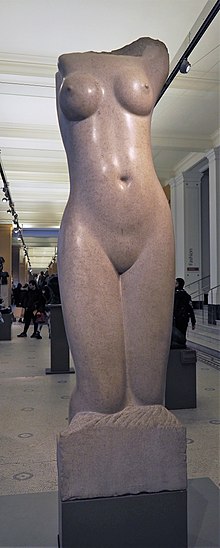
In August 1924, the Gills left Ditchling and, with two other families, moved to a disused Anglican monastery,Llanthony Abbey,atCapel-y-ffinin the Black Mountains of Wales.[2]: 179 The dilapidated building was high in an isolated valley about fourteen miles fromAbergavenny.Finding the monastery chapel beyond repair, a new one was quickly built and aBenedictinemonk fromCaldey Abbeywas assigned to the group to hold a daily Mass.[2]: 182 Donald Attwaterarrived at Capel-y-ffin shortly before the Gills,David Jonesand René Hague, Joan Gill's future husband, all joined shortly after.[2]: 182 Joseph Cribb did not make the move to Wales but his younger brother, Lawrence Cribb (1898–1979), did and eventually became Gill's main assistant.[5]
Within a few weeks of arriving at Capel-y-ffin, Gill completedDeposition,a black marble torso of Christ, and madeThe Sleeping Christ,a stone head now inManchester City Art Gallery.[2]: 185 In 1926 he completed a sculpture ofTobias and Sarafor the library ofSt John's College, Oxford.[29]A war memorial altarpiece in oak relief for Rossall School was completed in 1927.[1]
When approached, in 1924, byRobert Gibbingsto produce designs for theGolden Cockerel Presswhich he and his wife, Moira, had recently acquired, Gill initially refused to work with the couple as they were not Catholics. Gill changed his mind when they sought to publish a volume of poems by his sister Enid. The relationship between Gill and the Gibbingses grew such that throughout the following ten years Gill became the chief engraver and illustrator for the Golden Cockerel Press. Several of the resulting books, includingThe Song of Songs(1925),Troilus and Criseyde(1927),The Canterbury Tales(1928), andThe Four Gospels(1931) are considered classics of specialist book production.[2]: 187 Gill created striking designs that unified and integrated illustrations into the text and also created a new typeface for the Press.[5]The erotic nature ofThe Song of Songsand of the illustrations forEdward Powys Mathers'sProcreant Hymncaused considerable controversy in Roman Catholic circles and led to protracted arguments between Gill and members of the clergy.[2]: 211 [30]The Golden Cockerel printed four of Gill's own books and he illustrated a further thirteen works for the press.[5]In addition, between 1924 and his death, Gill wrote 38 books and illustrated a further 28.[5]
The other key working relationship Gill established while at Capel-y-ffin was withStanley Morison,the Typographic Advisor to theMonotype Corporation.Morison persuaded Gill to apply the skills and knowledge he had gained in letter cutting to fonts suitable for mechanical reproduction.[2]: 187 It was at Capel that Gill designed the typefacesPerpetua(1925),Gill Sans(1927 onwards) and began work onSolus(1929).[1]Gill Sans is considered one of the most successful typefaces ever designed and remains in widespread use.[30][a]
While living at Capel-y-ffin, Gill spent many weekends at Robert and Moira Gibbings' home inWaltham St Lawrence,enjoying the couple's unconventional and hedonistic lifestyle.[2]: 191 He was also spending sizable amounts of time in Bristol with a group of young intellectuals centred aroundDouglas Cleverdon,a bookseller who published and distributed some of Gill's writings.[2]: 192 From 1925 onwards, Gills' secretary, and mistress, was Elizabeth Bill. Bill owned a villa set in several acres in the French Pyrenees atSalies-de-Béarnand which the Gills often visited.[2]: 205 The Gill family spent the winter of 1926–27 there, and which was where Gill did many of the engravings forTroilus and Criseyde.[2]: 215 For the last months of 1927 he worked in a studio in London at Glebe Place in Chelsea creating the sculpture originally known asHumanityand now calledMankind.The work, a giant torso, was modelled by Angela Gill and shown at theGoupil Galleryin London, to considerable acclaim, before being purchased by the artistEric Kennington.[2]: 220 [33]Some years later, Kennington offered the work toWhipsnade Zoo.The zoo refused the offer, and the work is now in theTatecollection but displayed at the Victoria and Albert Museum.[2]: 220 [8]
It had been too impractical to transport the stone forMankindto Capel-y-ffin and it was clear that the site had become too remote and isolated for Gill's increasing commercial workload and by May 1928 he was seeking a new home for his family and workshops.[2]: 221 [30]
-
Gill Sans
-
Joanna Nova
-
Perpetua
-
Golden Cockerel type
-
Three typefaces by Gill
Pigotts, Buckinghamshire 1928–1934
[edit]In October 1928, the Gill family moved to Pigotts atSpeen,five miles fromHigh Wycombein Buckinghamshire. Around a quadrangle with a central pigsty were a large farmhouse housing Eric and Mary Gill, a cottage for Petra and her husband Denis Tegetmeier and another for Joanna and René Hague. Stables and barns were converted to studios and workshops and to house printing presses.[2]: 225 A chapel was fitted into one corner and licensed within six months for the saying of Mass.[2]: 226

The success of his 1928 exhibition at the Goupil Gallery had raised Gill's profile considerably and led toCharles Holdencommissioning him to lead a team of five sculptors, includingHenry Moore,in creating some of the external sculptures for the new headquarters building of theLondon Electric Railway,the forerunner ofLondon Underground.[2]: 228 Gill started on the project within days of arriving at Pigotts and worked on site in London from November 1928 to carve three of eight relief sculptures on the theme ofThe Four Windsfor the building.[2]: 229
Art-Nonsense And Other Essays by Eric Gillwas published in 1929 and marked the first commercial use of thePerpetuatypeface. The frontispiece of the book had an engraving ofBelle Sauvage,an image of a naked women stepping out of some woods. The various versions ofBelle Sauvagebecame among the most popular of Gill's illustrations and were modelled byBeatrice Warde,a historian of typography, an executive of the Monotype Corporation and sometimes Gill's lover.[2]: 232 By 1930 Gladys Gill had divorced her second husband after her first, Ernest Laughton, had been killed in theBattle of the Somme,and she and Eric appear, from his diary entries, to have resumed their incestuous relationship.[2]: 239 Later that same year the diaries record what Gill called his 'experiments' with a dog.[2]: 239 In September 1930 he was taken seriously ill with a variety of symptoms, including amnesia, and spent several weeks in hospital.[2]: 237

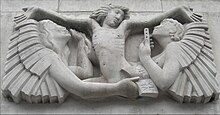
The following two years were among the most creatively accomplished of Gill's career, with several notable achievements. The Hague and Gill press was established at Pigotts in 1931 and eventually printed 16 of Gill's own books and booklets while he also illustrated six other books for the company.[5]For the Hague and Gill press he created theJoannatypeface, which was eventually adapted for commercial use by Monotype. He completedThe Four Gospels,widely considered to be the finest of all the books produced by the Golden Cockerel Press, and began working on the sculptureProspero and Arielfor the BBC'sBroadcasting Housein London.[2]: 243 Throughout 1931 and into 1932, Gill worked onProspero and Ariel,and four other works for the BBC, on site in central London.[2]: 245 Carving in the open air up on scaffolding in the middle of London further increased Gill's public profile.[2]: 247 Although Gill had accepted the BBC's choice of subject matter when he took the commission, he did not see its relevance and frequently claimed that the figures he created represented God the Father and God the Son, the latter complete with the marks of thestigmata.[8][34]
TheMidland Hotel, Morecambewas built in 1932–33 by theLondon Midland & Scottish Railwayto theArt Decodesign ofOliver Hilland includedseveral worksby Gill,Marion Dorn,andEric Ravilious.For the project Gill, with Lawrence Cribb andDonald Potter,produced two seahorses, modelled as Morecambe shrimps, for the outside entrance; a round plaster relief on the ceiling of the circular staircase inside the hotel; a decorative wall map of the north-west of England; and a large stone relief ofOdysseusbeing welcomed from the sea byNausicaafor the entrance lounge.[35]While working in Morecambe, Gill met May Reeves, who became a regular visitor to Pigotts before moving there to run a small school and becoming Gill's resident mistress for several years.[2]: 256
Jerusalem and Pigotts, 1934–1938
[edit]
In 1934 Gill, with Lawrence Cribb, visited Jerusalem to work at thePalestine Archaeological Museum,now theRockefeller Archaeological Museum.[2]: 263 [36]There they carved a stonebas-reliefof the meeting of Asia and Africa above the front entrance, together with ten stone reliefs illustrating different cultures, and a gargoyle fountain in the inner courtyard. He also carved stone signage throughout the museum in English, Hebrew and Arabic.[36]
Gill's two visits to Jerusalem had a profound impact on his state of mind. He became increasingly unhappy with the impact of humanity upon the world and also become convinced of his own role as one chosen by God to change society.[2]: 263 Returning to England, Gill's mood of pessimism deepened with the death of his son-in-law, David Pepler, and he became increasingly antagonistic towards the Church and towards other artists.[2]: 265 Paradoxically, alongside this despondent world view Gill dropped his long-standing opposition to the use of modern home comforts and appliances. A bathroom was installed at Pigotts, a chauffeur and a gardener were appointed and his secretaries were allowed to use typewriters.[2]: 266 Religious observance was no longer expected of the workshop staff and among the additional apprentices and assistants Gill employed were a number of non-Catholics, includingWalter Ritchie.[2]: 249 Prudence Pelham, the daughter of the Earl of Chichester, became Gill's only female apprentice.[2]: 250 During his career, Gill employed at least twenty-seven apprentices including his nephewJohn Skelton,Hilary Stratton,Desmond Chute,David KindersleyandDonald Potter.[8][22][37]
Gill's 1935 essayAll Art is Propagandamarked a complete reversal of his previous belief that artists should not concern themselves with political activity.[2]: 272 He became a supporter ofsocial creditand later moved towards asocialistposition.[38]In 1934, Gill contributed art to an exhibition mounted by the left-wingArtists' International Association,and defended the exhibition against accusations inThe Catholic Heraldthat its art was "anti-Christian".[39]Gill became a regular speaker at left-wing meetings and rallies throughout the second half of the 1930s.[2]: 273 He was adamantly opposed tofascism,and was one of the few Catholics in Britain to openly support theSpanish Republicans.[38]Gill became a pacifist and helped set up the Catholic peace organisation Pax withE. I. WatkinandDonald Attwater.[40]Later, Gill joined thePeace Pledge Unionand supported the British branch of theFellowship of Reconciliation.[38]
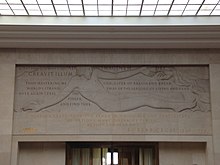
Gill was commissioned to produce a sequence of seven bas-relief panels for the façade of The People's Palace, now the Great Hall ofQueen Mary University of London,which opened in 1936. In 1937, he designed the background of the firstGeorge VIdefinitive stampseries for the post office.[41][42]In 1938 Gill was commissioned to create a mammoth artwork for thePalace of Nationsbuilding in Geneva, as the British Government's gift to theLeague of Nations.[2]: 275 Gill's original proposal was to create a larger, international, version of theMoneychangersfrieze that had caused such outrage in Leeds years earlier, but after objections from delegates to the League, submitted an alternative scheme.The Creation of Manflanked byMan's Gifts to GodandGod's Gifts to Manare three marble bas-reliefs in seventeen sections and constitute the largest single work Gill created during his career but are not considered among his finest works.[2]: 276 [43]
In 1935, Gill was elected an Honorary Associate of theInstitute of British Architectsand in 1937 was made aRoyal Designer for Industry,the highest British award for designers, by theRoyal Society of Arts,and became a founder-member of the RSA's Faculty of Royal Designers for Industry when it was established in 1938.[2]: 271 In April 1937, Gill was elected an associate member of theRoyal Academy.Quite why Gill was offered, let alone accepted, these honours from institutions he had openly reviled throughout his career is unclear.[1]
Final works, 1939–1940
[edit]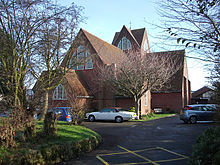

During 1938 and 1939 Gill designed his only complete piece of architecture, the Roman Catholic Church of St Peter the Apostle atGorleston-on-Sea.[1]He designed the building around a central altar which, at the time, was considered a radical departure from the Catholic practice of the altar being at the east end of a church.[2]: 280
Gill's final publications includedTwenty-Five NudesandDrawings from Lifeboth of which included drawings of Daisy Hawkins, the teenage daughter of the Gills' housekeeper with whom Gill began an affair in 1937.[1]The affair lasted two years during which time Gill drew her on an almost daily basis. When Hawkins was sent away from Pigotts, to the boarding house at Capel-y-ffin run by Betty Gill, Eric Gill followed her there to continue the relationship.[2]: 284
Among Gill's last sculptures were a series of commissions forGuildford Cathedral.He spent time between October and December 1939 working at Guildford, on scaffolding carving the figure ofJohn the Baptist.[1]He also worked on a set of panels depicting the stations of the cross for the Anglican St Alban's Church in Oxford, finishing the drawings three weeks before he died and completing nine of the pieces himself.[44][29]For the Chapel of Saint George and the English Martyrs, in Westminster Cathedral, Gill designed a low relief sculpture to occupy the wall behind the altar.[16]Gill's design showed a life-sized figure of Christ the Priest on the cross attended by SirThomas MoreandJohn Fisher.[16]Gill died before the work was completed and Lawrence Cribb was tasked with finishing the piece by the Cathedral authorities who insisted he remove an element of Gill's original design, a figure of a pet monkey.[16]When the chapel was eventually opened to the public this censorship of Gills' last work was a matter of some considerable controversy.[16]
From the end of 1939 into the middle of 1940, Gill had a series of illnesses, includingrubella,but managed to write his autobiography that summer.[1]Gill died oflung cancerinHarefield HospitalinMiddlesexon the morning of Sunday 17 November 1940 and, after a funeral mass at the Pigotts chapel, was buried in Speen's Baptist churchyard.[1]
After Gill died an inventory of over 750 of his carved inscriptions was compiled, in addition to the over 100 stone sculptures and reliefs, 1000 engravings, the several typeface designs he created and his 300 printed works including books, articles and pamphlets.[2]: 294
Sexual abuse
[edit]Gill's religious beliefs did not limit his sexual activity, which included several extramarital affairs. His religious views contrast with hisdeviantsexual behaviour,including, as described in his personal diaries, thechild sexual abuseof his adolescent daughters, an incestuous relationship with at least one of his sisters, and also sexual experiments with a dog.[4][10][45]Since these revelations became public in 1989, there have been a number of calls for works by Gill to be removed from public buildings and art collections. This aspect of Gill's life was little known beyond his family and friends until the publication of the 1989 biography byFiona MacCarthy.[46]A 1966 biography byRobert Speaightmentioned none of it.[46]
Gill's daughter Petra Tegetmeier, who was alive at the time of the MacCarthy biography, described her father as having "endless curiosity about sex" and that "we just took it for granted", and told her friendPatrick Nuttgensshe was unembarrassed. The children were educated at home and, according to Tegetmeier, she was then unaware of how her father's behaviour would seem to others.[17][47]Despite the acclaim the book received, and the widespread revulsion towards aspects of Gill's sexual life that followed publication, MacCarthy received some criticism for revealing Gill's incest in his daughter's lifetime.[48][49]Others, notablyBernard Levin,thought she had been too indulgent towards Gill.[46]MacCarthy commented:
after the initial shock, [...] as Gill's history of adulteries, incest, and experimental connection with his dog became public knowledge in the late 1980s, the consequent reassessment of his life and art left his artistic reputation strengthened. Gill emerged as one of the twentieth century's strangest and most original controversialists, a sometimes infuriating, always arresting spokesman for man's continuing need of God in an increasingly materialistic civilization, and for intellectual vigour in an age of encroaching triviality.[1]
Despite MacCarthy's revelations, for several years Gill's reputation as an artist continued to grow but, following the exposure of other high-profile paedophiles, this changed with groups and individuals calling for the removal of works by Gill.[50]
In 1998, a group, Ministers and Clergy Sexual Abuse Survivors, called for the Gill's Stations of the Cross to be removed from Westminster Cathedral, leading to a debate within the British Catholic press.[45][3]There were calls for Gill's statue ofSt Michael the Archangelto be removed from St Patrick's Catholic Church inDumbarton.[50]In 2016, some residents in Ditchling objected to a proposal to erect a plaque by the village war memorial which would have identified Gill as the maker of the monument.[50][51] In January 2022, a man climbed the façade of Broadcasting House and damaged the statue ofProspero and Arielwith a hammer, while another man shouted about Gill'spaedophilia.[52][53]Some 2,500 people had previously signed a petition calling on the BBC to take the work down.[54]In May 2023 the statue was again attacked by a man wielding a hammer.[55]Guildford Cathedralannounced in February 2022 that it was considering a 'new interpretation' concerning Gill's statues of John the Baptist and of Christ on the Cross which are on their building.[56]Several organisations, includingSave the Children,resolved to stop using typefaces designed by Gill.[57]
When, in 2017, the journalistRachel Cookecontacted museums holding Gill's work to question what, if any, impact the abuse revelations had on their policy towards showing material by him, the majority refused to engage with her.[50]A notable exception was theDitchling Museum of Art + Craft,which holds many examples of Gill's work and also Gill family objects. Previously, in October 2016, the museum had held a workshop,Not Turning a Blind Eye,with artists, curators and journalists invited to discuss how to address Gill's behaviour in its exhibition programme.[50]This resulted in a 2017 exhibitionEric Gill: The Bodyand a commitment by the museum to include at least one display highlighting Gill's offending in its permanent exhibitions.[50][58]However in 2022,The Observerreported that it appeared that the museum had decided to reduce the prominence given to Gill's work among its exhibits.[59]
Typefaces and inscriptions
[edit]In 1909, Gill carvedAlphabets and Numeralsfor a book,Manuscript and Inscription Letters for Schools and Classes and for the Use of Craftsmen,compiled by Edward Johnston. He later gave them to the Victoria and Albert Museum so they could be used by students at the Royal College of Art. In 1914, Gill had met the typographerStanley Morison,later a typographic consultant for theMonotype Corporation.Commissioned by Morison, he designed theGill Sanstypeface in 1927–30.[60]Gill Sans was based on the sans-serif lettering originally designed for theLondon Underground.Gill had collaborated withEdward Johnstonin the early design of the Underground typeface, but dropped out of the project before it was completed. In 1925, he designed thePerpetuatypeface for Morison, with the uppercase based upon monumental Roman inscriptions. An in-situ example of Gill's design and personal cutting in the style of Perpetua can be found in the nave of the church inPoling, West Sussex,on a wall plaque commemorating the life ofSir Harry Johnston.[citation needed]In the period 1930–31, Gill designed the typefaceJoannawhich he used to hand-set his book,An Essay on Typography.
-
Alphabets and Numerals (1909)
-
SirHarry Johnstonmemorial plaque
-
British Railwayssign atLowestoft railway stationin Gill Sans
-
Gill Sans typeface
Gill's other types include:
- Golden Cockerel Press Type (for theGolden Cockerel Press;1929)[61]Designed bolder than some of Gill's other typefaces to provide a complement to wood engravings.[62][63][64][65][66]
- Solus(1929)[67][61]
- Aries (1932)[61]
- Floriated Capitals (1932)[61]
- Bunyan (1934)
- Pilgrim (recut version of Bunyan; 1953)[61]
- Jubilee (also known as Cunard; 1934)[61]
These dates are not precise, since a lengthy period could pass between Gill creating a design and it being finalised by the Monotype drawing office team (who would work out many details such as spacing) and cut into metal.[68]In addition, some designs such as Joanna were released to fine printing use long before they became widely available from Monotype.
One of the most widely used British typefaces, Gill Sans, was used in the classic design system ofPenguin Booksand by theLondon and North Eastern Railwayand laterBritish Railways,with many additional styles created by Monotype both during and after Gill's lifetime.[68]In the 1990s, the BBC adopted Gill Sans for itswordmarkand many of its on-screen television graphics.
The family Gill Facia was created byColin Banksas an emulation of Gill's stone carving designs, with separate styles for smaller and larger text.[69]
Gill was commissioned to develop a typeface with the number ofallographslimited to what could be used onMonotype systemsorLinotype machines.The typeface was loosely based on the ArabicNaskhstyle but was considered unacceptably far from the norms of Arabic script. It was rejected and never cut into type.[70][71][72]
Published works
[edit]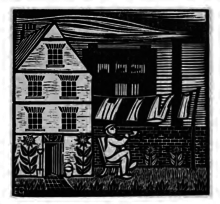
Gill published numerous essays on the relationship between art and religion, and a number of erotic engravings.[73]
Gill's published writings include:

- Christianity and Art,1927
- Art-nonsense and other essays,Cassell 1929 (pocket edition 1934)
- Clothes: An Essay Upon the Nature and Significance of the Natural and Artificial Integuments Worn by Men and Women,1931[74]
- An Essay on Typography,1931[75]
- Beauty Looks After Herself,1933
- Unemployment,1933
- Money and Morals,1934
- Art and a Changing Civilization,1934
- Work and Leisure,1935
- The Necessity of Belief,1935
- Work and Property,1937[76]
- Work and Culture,Journal of the Royal Society of Arts,1938
- Twenty-five nudes,1938[77]
- And Who Wants Peace?,1938
- Sacred and Secular,1940
- Autobiography: Quod Ore Sumpsimus[78]
- Notes on Postage Stamps[79]
- Christianity and the Machine Age,1940.[80]
- On the Birmingham School of Art,1940
- Last Essays,1943
- A Holy Tradition of Working: passages from the writings of Eric Gill1983.[81]
Gill provided woodcuts and illustrations for several books including:
- Gill, Eric (1925).Song of Songs.Waltham St. Lawrence, Berkshire: Golden Cockerel Press.
- The Four Gospels.Golden Cockerel Press. 1931.Facsimile edition published by Christopher Skelton at the September Press, Wellingborough, 1987.
- Chaucer, Geoffrey (1932).Troilus and Criseyde.Translated by Krapp, George Philip. New York: Literary Guild.
- Shakespeare, William (1939).Henry the Eighth.New York: Limited Editions Club.
- The Passion of Our Lord Jesus Christ, according to the four evangelists. Hague & Gill Printers. 1934 Faber & Faber
-
Eve,1926
-
Christ on the Cross
-
Angels Trumpet
-
Autumn Midnight,c. 1923
-
Mrs Ruth Lowinsky
Archive
[edit]Gill's papers and library are archived at theWilliam Andrews Clark Memorial LibraryatUCLAin California, designated by the Gill family as the repository for his manuscripts and correspondence.[82]Some of the books in his collection have been digitised as part of theInternet Archive.[83]Additional archival and book collections related to Gill and his work reside at theUniversity of Waterloo Library[6]and the University of Notre Dame'sHesburgh Library.[84]Much of Gill's work and memorabilia is held and is on display at theDitchling Museum of Art + Craft.
Notes
[edit]- ^The German diplomatHarry Graf Kesslervisited Gill in Wales in January 1925.[31]: 245–246 They had known each other before theFirst World Warand Kessler wanted to persuade Gill to provide some calligraphy for a version ofVirgil'sEclogues,which was to be published by Kessler's Cranach Press. Kessler recorded his impressions of his friend in his diary: "He really is an extraordinary and noteworthy personality, with his great artistic talent, utter repudiation of modern commercialism and eccentric piety translated into an all-embracing sensuousness".[32]: 257
References
[edit]- ^abcdefghijklmnopqFiona MacCarthy(25 September 2014) [23 September 2004]."Gill, (Arthur) Eric Rowton".Oxford Dictionary of National Biography(online ed.). Oxford University Press.(Subscription orUK public library membershiprequired.)
- ^abcdefghijklmnopqrstuvwxyzaaabacadaeafagahaiajakalamanaoapaqarasatauavawaxayazbabbbcbdbebfbgbhbibjbkblbmbnbobpbqbrbsbtbubvbwbxbybzcacbcccdcecfcgFiona MacCarthy(1989).Eric Gill.Faber & Faber.ISBN0-571-14302-4.
- ^abJames Williams (27 April 2017)."Eric Gill's fall from grace".Apollo.Retrieved19 January2022.
- ^abcdefFiona MacCarthy(22 July 2006)."Written in stone".The Guardian.Retrieved9 November2017.
- ^abcdefghijRuth Cribb & Joe Cribb (2011).Eric Gill: Lust for Letter & Line.The British Museum Press.ISBN978-0-7141-1819-2.
- ^ab"Eric Gill archival and book collection".University of Waterloo Library.Retrieved18 May2016.
- ^"Eric Gill in Hammersmith"(PDF).Hammersmith and Fulham Historic Buildings Group Newsletter(33 (Winter 2015)): 6. 2015.Retrieved13 August2021.
- ^abcdeRuth Cribb (2007)."Eric Gill at the Victoria and Albert Museum New Sculpture Display".Antiques & Fine Art Magazine.Retrieved18 February2022.
- ^ab"Madonna and Child".National Museum Wales.Retrieved23 January2022.
- ^abcFiona MacCarthy(17 October 2009)."Mad about sex".The Guardian.Retrieved17 October2009.
- ^"Video of a Lecture at London University detailing Gill's interest in Indian Sculpture".London University School of Advanced Study.March 2012.
- ^Rupert Richard Arrowsmith (2010).Modernism and the Museum: Asian, African, and Pacific Art and the London Avant-Garde.Oxford University Press.pp. 74–103.ISBN978-0-19-959369-9.
- ^abStephen Stuart-Smith (2003)."Gill, (Arthur) Eric (Rowton)".Grove Art Online.doi:10.1093/gao/9781884446054.article.T032249.Retrieved21 January2022.
- ^abcdefgDavid V Barrett (5 August 2021)."Eric Gill: a moral problem".The Catholic Herald.Retrieved12 February2022.
- ^abPatrick Rogers (2005)."Stations of the Cross".Westminster Cathedral.Archived fromthe originalon 20 January 2022.Retrieved20 January2022.
- ^abcdefghiPeter Doyle (1995).Westminster Cathedral 1895–1995.Geoffrey Chapman.ISBN0225666847.
- ^abPatrick Nuttgens (6 January 1999)."Petra Tegetmeier obituary".The Guardian.Retrieved19 February2016.
- ^Historic England."Trumpington War Memorial (1245571)".National Heritage List for England.Retrieved11 January2020.
- ^"War Memorials Register: Chirk".Imperial War Museum.Retrieved3 April2020.
- ^Historic England."Ditchling War Memorial (1438295)".National Heritage List for England.Retrieved11 January2020.
- ^Historic England."Briantspuddle War Memorial (1171702)".National Heritage List for England.Retrieved7 March2020.
- ^abHistoric England."Harting War Memorial (1438494)".National Heritage List for England.Retrieved7 March2020.
- ^"War Memorials Register: Victoria and Albert Museum Staff − WW1".Imperial War Museum.Retrieved10 February2022.
- ^"Memorial tablet commemorating Museum personnel killed in the First World War".Victoria & Albert Museum.Retrieved12 February2022.
- ^Historic England."Church of St Cuthbert (Roman Catholic) (1376263)".National Heritage List for England.Retrieved16 February2022.
- ^"Eric Gill – Christ driving the Moneychangers from the Temple".University of Leeds.
- ^"War Memorials Register: University of Leeds − WWI Eric Gill Frieze".Imperial War Museum.Retrieved10 February2022.
- ^Penelope Curtis (4 November 2021)."Memory and mourning: on sculpting modern memorials".Art UK.Retrieved4 July2022.
- ^abMartin Stott (8 December 2011)."Eric Gill in Oxford".Oxford Mail.Retrieved16 January2022.
- ^abcPeter Lord(2006).The Tradition A New History of Welsh Art 1400–1990.Parthian.ISBN978-1-910409-62-6.
- ^Harry Graf Kessler(2000). Charles Kessler (ed.).The Diaries of a Cosmopolitan: 1918-1937.London: Phoenix Press.ISBN1-84212-061-1.
- ^Kessler
- ^"Catalogue entry:Mankind1927-8 ".Tate.2004.Retrieved8 March2022.
- ^"Catalogue entry:Prospero and Ariel1931 ".Tate.Retrieved8 March2022.
- ^Barry Guise & Pam Brook (2008).The Midland Hotel. Morecambe's White Hope.Lancaster, England: Palatine Books.ISBN978-1-874181-55-2.
- ^ab"Eric Gill, 1882–1940".East Meets West: The Story of the Rockefeller Museum.Israel Museum.Retrieved31 January2016.
- ^Donald Potter (1980).My Time with Eric Gill: A Memoir.Gamecock Press.ISBN0-9506205-1-3.
- ^abcMartin Ceadel (1980).Pacifism in Britain, 1914–1945: The Defining of a Faith.Oxford, England: Clarendon Press. pp.281, 289–91, 295, 321.ISBN0-19-821882-6.
- ^Charles Harrison (1981).English Art and Modernism 1900–1939.London: Allen Lane. pp.251–2.ISBN0-253-13722-5.
- ^Patrick G. Coy (1988).A Revolution of the Heart: Essays on the Catholic Worker.Philadelphia: Temple University Press. p.76.ISBN0-87722-531-1.
- ^Peter Worsfold (2001).Great Britain King George VI Low Value Definitive Stamps.The Great Britain Philatelic Society.ISBN0-907630-17-0.
- ^"Eric Gill Postage Stamps by Type Designer".The Offices of Kat Ran Press.Retrieved31 January2018.
- ^"Lobby of the Council Chamber".United Nations.Retrieved11 March2022.
- ^"Stations of the Cross by Eric Gill at St Alban's Church".Ss Mary & John Churchyard.Archived fromthe originalon 13 January 2022.Retrieved12 January2022.
- ^abFinlo Roher (5 September 2007)."Can the art of a paedophile be celebrated?".BBC News.Retrieved10 August2008.
- ^abcFiona MacCarthy (24 July 2004)."Baptism by fire".The Guardian.Retrieved9 November2017.
- ^"The Darker Side of Ditchling".Brighton Argus.9 January 1999.Retrieved19 February2016.
- ^Lottie Hoare (9 January 1999)."Petra Tegetmeier obituary".The Independent.Retrieved19 February2016.
- ^Barbara Harrison (7 May 1989)."A Lover's Quest for Art and God".The New York Times.Retrieved19 February2016.
- ^abcdefRachel Cooke(9 April 2017)."Eric Gill: Can we separate the artist from the abuser?".The Observer.Retrieved28 January2022.
- ^Adrian Imms (1 November 2016)."Villagers furious over plinth for paedophile sculptor".Brighton Argus.Retrieved24 January2022.
- ^Jim Waterson (12 January 2022)."Man uses hammer to attack statue on front of BBC Broadcasting House".The Guardian.Retrieved12 January2022.
- ^Ruth Millington (16 February 2022)."Can you separate the artist from the art?".Art UK.Retrieved23 February2022.
- ^Sabrina Johnson (12 January 2022)."Man takes hammer to BBC headquarters to smash statue by paedophile sculptor".Metro.Retrieved13 January2022.
- ^"Man scales BBC HQ and hits statue with hammer".BBC News.20 May 2023.Retrieved20 May2023.
- ^Patrick Hudson (2 February 2022)."Eric Gill sculptures under scrutiny at Guildford Cathedral".The Tablet.Retrieved6 February2022.
- ^Catherine Bennett (16 January 2022)."Sometimes a statue is indefensible – the BBC should get rid of Eric Gill".The Observer.Retrieved29 January2022.
- ^Michéle Woodger (12 May 2017)."Ditchling comes clean about Gill".The RIBA Journal.Retrieved18 February2022.
- ^John Sturgis (18 December 2022)."Airbrushing claim as 'Eric Gill museum' shuns legacy of artist and sexual abuser".The Observer.Retrieved7 March2023.
- ^Mosley, James(2001). "Review: A Tally of Types".Journal of the Printing History Society.3.London, England: Printing History Society: 63–67.
- ^abcdef"Eric Gill (1882–1940), Fonts designed by Eric Gill".Identifont.Archivedfrom the original on 5 October 2021.Retrieved31 January2018.
- ^Mosley, James."Eric Gill and the Cockerel Press".Upper & Lower Case.International Typeface Corporation. Archived fromthe originalon 29 July 2012.Retrieved7 October2016.
- ^Brignall, Colin."The Digital Development of ITC Golden Cockerel".International Typeface Corporation.Archived fromthe originalon 14 June 2012.Retrieved8 February2017.
- ^Carter, Sebastian."The Golden Cockerel Press, Private Presses and Private Types".International Typeface Corporation.Archived fromthe originalon 21 May 2012.Retrieved8 February2017.
- ^Dreyfus, John."Robert Gibbings and the quest for types suitable for illustrated books".International Typeface Corporation.Archived fromthe originalon 21 May 2012.Retrieved8 February2017.
- ^Yoseloff, Thomas."A Publisher's Story".International Typeface Corporation.Archived fromthe originalon 20 May 2012.Retrieved8 February2017.
- ^Bates, Keith."The Non Solus Story".K-Type.Retrieved21 July2015.
- ^abRhatigan, Dan (September 2014)."Gill Sans after Gill"(PDF).Forum(28). Letter Exchange.Archived(PDF)from the original on 15 February 2015.Retrieved28 July2015.Dan Rhatigan is (or was) Type Director at Monotype.
- ^Banks, Colin."Gill Facia MT".Fontshop.Monotype.Retrieved30 August2015.
- ^Blair, S.S.Islamic Calligraphy.p. 606, Fig. 13.7.
- ^"Eric Gill"(PDF).The Monotype Recorder.41(3). 1958.Archived(PDF)from the original on 21 October 2021.Retrieved16 September2015.
- ^Graalfs, Gregory (1998). "Gill Sands".Print.
- ^Christopher Skelton (ed.),Eric Gill, The Engravings,Herbert Press, 1990,ISBN1-871569-15-X.
- ^Gill, Eric (1931).Clothes: An Essay Upon the Nature and Significance of the Natural and Artificial Integuments Worn by Men and Women.Jonathan Cape.OCLC7320636.
- ^Gill, Eric. (1931).An Essay on TypographyISBN0-87923-762-7,ISBN0-87923-950-6(reprints).
- ^Gill, Eric (1937).Trousers & The Most Precious Ornament.London: Faber and Faber.OCLC5034115.
- ^Gill, Eric (1951)."Twenty-Five Nudes".J. M. Dent & Sons.
- ^Gill, Eric (1940).Autobiography: Quod Ore Sumpsimus.(published posthumously). Jonathan Cape.ISBN1-870495-13-6.
- ^Gill, Eric. (2011).Notes on Postage StampsKat Ran Press, 2011.ISBN0-9794342-1-1.
- ^In the seriesChristian Newsletter Books,The Sheldon Press.
- ^Gill, Eric; Keeble, Brian (1983).A Holy Tradition of Working: passages from the writings of Eric Gill.Ipswich: Golgonooza Press.ISBN0-903880-30-X.(reprinted 2021 by Angelico Press,ISBN978-1-62138-681-0).
- ^"Eric Gill Artwork Collection".Online Archive of California.William Andrews Clark Memorial Library.Retrieved18 May2016.
- ^"Gill, Eric, 1882–1940, former owner".Internet Archive.California Digital Library.Retrieved18 May2016.
- ^"The Eric Gill Collection".University of Notre Dame Hesburgh Libraries.Rare Books & Special Collections. Archived fromthe originalon 5 September 2015.Retrieved18 May2016.
Further reading
[edit]- Thorp, Joseph (1929).Eric Gill.London: Jonathan Cape.ASINB0008B8S9Q.
- Speaight, Robert (1966).Life of Eric Gill.London: Methuen & Co.ISBN0-416-28600-3.
- Gill, Cecil; Warde, Beatrice; Kindersley, David (1968).The Life and Works of Eric Gill.Papers read at a Clark Library symposium, 22 April 1967. Los Angeles: William Andrews Clark Memorial Library, University of California.
- Attwater, Donald (1969).A Cell of Good Living.London: G. Chapman.ISBN0-225-48865-5.
- Harling, Robert (1976).The letter forms and type designs of Eric Gill.Westerham: Eva Svensson.ISBN0-903696-04-5.
- Yorke, Malcolm (1981).Eric Gill: Man of Flesh and Spirit.London: Constable.ISBN0-09-463740-7.
- Kindersley, David(1982) [1967].Mr. Eric Gill: Further Thoughts by an Apprentice.Cardozo Kindersley Editions.ISBN0-9501946-5-4.
- Fuller, Peter (1985).Essay: Eric Gill,: a Man of Many Parts. Images of God, The Consolations of lost Illusions.Chatto & Windus.
- Corey, Steven; MacKenzie, Julia, eds. (1991).Eric Gill: A Bibliography.St Paul's Bibliographies.ISBN0-906795-53-2.
- Miles, Jonathan (1992).Eric Gill & David Jones at Capel-y-ffin.Bridgend, Mid Glamorgan: Seren Books.ISBN1-85411-051-9.
- Bringhurst, Robert (1992).The Elements of Typographic Style.Hartley & Marks.ISBN0-88179-033-8.
- Peace, David; Gill, Evan, eds. (1994).Eric Gill: the inscriptions; a descriptive catalogue; based on the inscriptional work of Eric Gill.London: Herbert Press.ISBN978-1-871569-66-7.
- Collins, Judith (1998).Eric Gill: The Sculpture.Woodstock, NY: Overlook Press.ISBN0-87951-830-8.
- Fiedl, Frederich; Ott, Nicholas; Stein, Bernard (1998).Typography: An Encyclopedic Survey of Type Design and Techniques Through History.Black Dog & Leventhal.ISBN1-57912-023-7.
- Pincus, J.W; Turner Berry, W.; Johnson, A. F. (2001).Encyclopædia of Type Faces.London: Cassell Paperback.ISBN1-84188-139-2.
- Holliday, Peter (2002).Eric Gill in Ditchling.Oak Knoll Press.ISBN1-58456-075-4.
- Dodd, Robin (2006).From Gutenberg to OpenType.Hartley & Marks.ISBN0-88179-210-1.
- Macmillan, Neil (2006).An A–Z of Type Designers.Yale University Press.ISBN0-300-11151-7.
External links
[edit]- 67 artworks by or after Eric Gillat theArt UKsite
- Biography of Gill on website of The Guild of St Joseph and St Dominic,with commentary on his 'unorthodox' interpretation of Catholicism
- Manuscript & Inscription Letters,Edward Johnston,1909 (plates by Gill)
- Portraits of Gill in the National Portrait Gallery, London
- Portraits by Gill in the National Portrait Gallery, London
- Prints and drawings by Gill in the British Museum collection
- Twenty-five Nudes,Gill, 1938 (collected drawings)
- Troilus and Criseyde,Geoffrey Chaucer,translated by George Philip Knapp, 1932
- Works by Gill in the National Museum Wales collection(woodcuts by Gill)
- 1882 births
- 1940 deaths
- 20th-century British printmakers
- 20th-century English essayists
- 20th-century English sculptors
- 20th-century Roman Catholics
- 20th-century engravers
- 20th-century English diarists
- Academics of the Central School of Art and Design
- Alumni of the Central School of Art and Design
- Alumni of the Westminster School of Art
- Artists from Brighton
- Arts and Crafts movement
- Associates of the Royal Academy
- British architectural sculptors
- British erotic artists
- British letter cutters
- British stamp designers
- Burials in Berkshire
- Child sexual abuse in England
- Converts to Roman Catholicism
- Deaths from lung cancer in England
- English anti-fascists
- English graphic designers
- English illustrators
- English male sculptors
- English pacifists
- English rapists
- English Roman Catholics
- English sex offenders
- English socialists
- English typographers and type designers
- English wood engravers
- Incest
- Monumental masons
- People from Ditchling
- Stone carvers
- Zoophilia
- Members of the Fabian Society
- English pamphleteers
- Writers from Sussex


